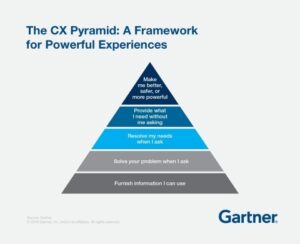- …do not shy away from the deliberate steps that get you great results
Attaining success in any endeavour feels good and can be very rewarding. The challenge is how you sustain the success by maintaining the momentum that got you there; this is where the rubber hits the road. Your customer experience initiative has won you recognition, what you do next is as important as what got you there.
Maintaining your focus on delivering unique experiences requires a company-wide commitment transcending a mere handful of meetings. A comprehensive plan is needed to get everyone on the same page – which is what a customer experience strategy is all about.
Your next steps in sustaining the momentum are to learn from the experience and follow through with the set of plans, actions and guidelines designed to create and maintain a memorable customer experience. This requires a cross-functional approach, as your customers’ experience always spans the entire journey. The journey begins the moment they discover your company and continues across all subsequent interactions, including purchases, support calls, repurchases and word-of-mouth referrals.
The fact is that customers these days expect a great deal of personal care; and if you can’t give it to them, they are more likely than ever to walk away. I had the experience last weekend at a supermarket outlet. I couldn’t help noticing a few customers expressing sentiments about the behaviour of a cashier toward a customer. They were very uncharitable sentiments for a very small incident. This is how your reputation can quickly ebb away in the twinkle of an eye. How you address all these is as important as what got you there.
Today’s customer is highly empowered and can easily research your company (on Facebook, Google Reviews, etc.) before giving it a try. In other words, your customers have options like never before; therefore, you need to make a real impression if you want to retain their business. How you should respond to this is by creating an almost flawless customer journey. Here are a few suggestions on how to sustain your experience strategy.
First, facilitate a customer-centric company culture; second, develop effective customer feedback mechanisms; and third, aim to create memorable human experiences and reduce friction.
Facilitate a customer-centric company culture
The rule here is simple. Treat your customers how you would like to be treated. Start at the top if you want to inculcate a customer-centric culture where the mindsets focus on the needs, concerns and feelings of the customer. To gain buy-in from your internal and external stakeholders, you must be deliberate about your actions. It requires a process of consistent one-to-one interactions and constant improvement of product, service and operations to develop an intimate, successful experience for every customer.
According to research companies with the most mature customer experience, management have achieved success in their strategy through a strong company-wide buy-in for their initiatives – starting from leadership and cascading down to the rest of the team. Leadership is a key ingredient in successful CX strategy management.
According to Walker, the Experience Management Services firm, great leadership is anchored by outstanding listening skills. They stress that “The listening component is a really important way for CX professionals to have a pulse on what the root-cause-issues are, and that brings the credibility and depth of knowledge to the conversations they have within their organisations”. When leadership is focused on the customer, they will drive the right conversations and influence a customer-centric mindset.
Furthermore, by offering training and support continually you make customer-centricity a core feature of your business. Regular training reinforces customer-centric principles. By giving employees direct feedback, you help them understand how to improve and empower them to find creative solutions to customers’ problems. When there is buy-in across the organization, the end product is transparency. When there is transparency across the organization, it unites everyone and pushes them toward a common goal. The edict here is to be honest about wrong turns, and explain the rationale for trying and adopting new approaches.
Develop effective customer feedback mechanisms
Effective feedback will ensure that the customer’s voice is heard with clarity across all touchpoints in the customer journey. This must be performed both internally (among employees) and externally (customers). When feedback is shared throughout the company, it will help everyone create a better experience. Product teams will design with customers in mind, marketing will produce messages more aligned with customer drives, and customer service will better relate to customer struggles and find creative solutions.
Start from new hires ensuring that they understand your company’s mission, values and commitment to creating a seamless customer experience. Each employee potentially has the power to impact the experience – and they need to be educated about it and empowered to improve it. Drawing from the incident at the supermarket, there is an opportunity to learn at first-hand how customers react to seemingly abrasive behaviour from frontline staff. A recommended approach to analysing customer feedback is known as The Pyramid. Two uses of this pyramid are explained.
The version by Gartner in 2018 is explained as a method for categorising customer experience by impact. Like Maslow’s hierarchy of needs, the general idea is that the bottom layer meets the most basic expectations while the top offers the deepest fulfillment. Gartner recommends applying the pyramid to every customer touchpoint (sales, service interactions, etc.) individually to see how well you’re delivering at each stage.
The second type of pyramid works more like a customer journey map, except that it has more dimensions. It is designed to encompass the customer experience as a whole, bringing all the pieces together to make them easier to understand. This type of CX pyramid is used by Joshua Rossman, VP of CX at Oracle, and also makes it easier to measure customer experience. The layers are labelled as follows: (at the base) Furnish information I can use; the second level says Solve your problem when I ask; the third level says Resolve my needs when I ask; the fourth level says Provide what I need without me asking; and the fifth level says Make me better, safer or more powerful.

Source: Gartner 2008
This is used variously with other tools and approaches such as Customer Satisfaction surveys (measures how products and services supplied by a company meet or surpass customer expectation) and Net Promoter Score (Businesses use it to measure and track how they are perceived by their customers).
Aim to create memorable human experiences and reduce friction
The truth is that there is no single checklist for guaranteeing a good customer experience. The uniqueness of your business is what drives your customers’ needs, wants and feelings as they engage with your brand. The following are common behviours which help you achieve good to great customer experiences. Make listening to customers a top priority across the business, and use customer feedback to develop an in-depth understanding of your customers. Implement a fit-for-purpose feedback system to help you collect feedback; analyse it, and act on it regularly. As demonstrated in Gartner’s model, you aim to reduce friction and solve your customers’ specific problems and unique challenges.
It is not rocket-science: a good customer experience comes from asking your customers questions, listening to their responses and actioning their feedback. Some common characteristics of bad customer experience include long waiting times; imagine the common scenario of making a quick dash to the bank with a plan of returning to your desk at work ASAP, and you end up spending a few hours due to slow processes. Another bad experience is derived from a situation where employees lack understanding of customer needs; at some stores and supermarkets, the staff appear to be in their own world and will shoulder you out of their way as they fill the shelves.
Unresolved issues and questions can be frustrating. A colleague of mine went in to pay their electricity bill because the mobile app was not functioning. She had to wait not less than an hour because the network was slow. It was a week-day and she had to be at work. Note also that as much as automation is useful, be wary of too much automation and not enough of human touch; we must get the balance right. My experience in a supermarket where the self-checkout system failed me was compensated for by the manager offering me a free haul on the day. Non-personalised services can be a real bother, and a passive customer service personnel or agent will compound your bad day. Even more disconcerting is the rude or angry employee.
We all crave great and memorable experiences and do not hesitate to tell a good story when we encounter great experiences. These great experiences ultimately earn plaudits for the business. Truth be told, CX benefits are not easy to quantify. However, the benefits are immediately visible as your bottom-line shores-up effortlessly when you do things right.
 |
The Writer is a Management Consultant. He can be reached on 059 175 7205, [email protected],
https://www.linkedin.com/km-13b85717
|










